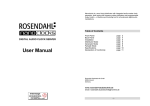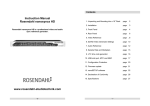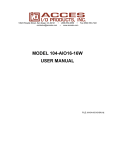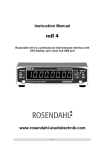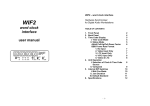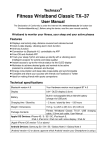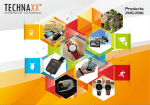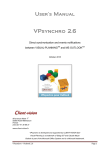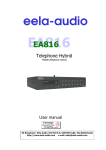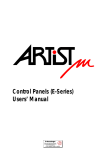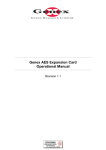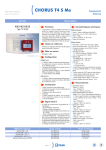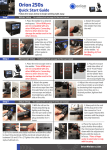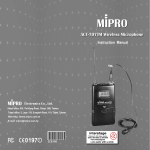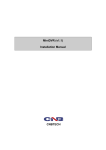Download Rosendahl Nanosync manual
Transcript
Nanosyncs is a universal synchronisable audio clock reference with multiple outputs and integrated video black & burst generator. Table of Contents User Manual Front Panel page 2 Back Panel page 4 Installation page 6 Unit Operation page 7 Specifications page 10 Declaration of Conformity page 12 ________________________________________ Rosendahl Studiotechnik GmbH 80804 Munich Germany www.rosendahl-studiotechnik.de email: [email protected] interstage Phistersvej 31, 2900 Hellerup, Danmark Telefon 3946 0000, fax 3946 0040 www.interstage.dk - pro audio with a smile Front Panel The four red LEDs +4%, +0.1%, -0.1, -4% indicate selected pull up / pull down factors. These sample rates are only used for special audio, video and film transfers. They should be off in normal operation at 48.000 or 44.100 kHz. 4. Output Multiplier LEDs 1. Power Switch Each of the six word clock outputs is individually configurable. The first three can be either the basic sampling rate (44.1 / 48kHz) or x2 (88.2 / 96kHz) and the second three basic sampling rates or x256 (Digidesign Super Clock). The six yellow LEDs indicate the selected multipliers. Turns the power to the Nanosyncs on and off. 5. Setup Keys 2. Reference LEDs Pressing the MENU key enters setup mode, the blinking LED indicates the current selected reference source. Subsequent depressions of the MENU key select the parameter to change: Reference Source Base Sample Rate Pull up / Pull down Wordclock frequency multiplier Depressing the SELECT key cycles through the options for each selected parameter. Once the desired parameters are set, pressing and holding the MENU key for approximately one second until the LEDs stops blinking stores the set up in non volatile memory. For a temporary set-up stay in setup mode. Turning of the unit when in setup mode and then re-powering the unit will re-set the previously stored parameters. Eight green LEDs indicate the selected reference for the DDS audio clock generator. The audio clocks can be resolved to the internal video sync generator, to external PAL video syncs, to external NTSC video syncs, to external word clock or to external LTC time code signals. 3. Sample Rate LEDs The red 48.000 and 44.100 LEDs indicate the selected basic sample rate. The blue LOCKED LED shows that the generated audio clocks are locked to the selected reference. This LED can have six different levels. See chapter „Unit Operation“ for more details. See also chapter „Unit Operation“ for more details. -2-3- Back Panel - 1. Video Outputs VO1-VO4 (BNC) four individual buffered 75 ohm video outputs. When Internal reference is selected these outputs are connected to the internal black & burst generator. In all other modes they distribute the video input signal. 5. SPDIF Output RCA connector, 75 ohms. This output can be connected to sound cards or other digital audio devices which do not have word clock inputs. 6. AES/EBU Null 2. Video Input BNC connector, 75 ohms terminated. You can select PAL and NTSC video sync signals as reference for the audio clock generator. XLR connector (GND1, +2, -3), transformer balanced, 110 ohms. Some professional digital audio devices can accept AES/EBU null sync signals. 7. Word Clock Outputs 3. Word Clock Input BNC connector, 75 ohms terminated. This input accepts wordclock signals from 40 to 51kHz @1.5-5Vpp as reference for the audio clock generator. BNC connectors, 75 ohms. WO1-WO3 can be either the basic sampling rate (44.1 / 48kHz) or x2 (88.2 / 96kHz) and WO4-WO6 basic sampling rates or x256 (Digidesign Super Clock). 4. LTC Time Code Inputs 8. Mains Input Two linked BNC connectors, high impedance. LTC time code can be linked through as the speed reference for the Nanosyncs audio clock generator. EN 60320, two pole. Use only the supplied AC power cord for the mains connection. 4- -5- Installation The Nanosyncs is shipped in two versions: 1.) 230 VAC, 50 Hz, internal PAL video generator, serial numbers Pxxxx 2.) 115 VAC, 60 Hz, internal NTSC video generator, serial numbers Nxxxx Check version and voltage on the back panel before connecting the unit to mains. Word clock cables should be under 10 metres to retain maximum benefit from the Nanosyncs jitter-free clocks. To supply three digidesign audio interfaces with multiple super clock signals, connect the first one with a 0,3 metres and the second and third with a 1,0 metres long cable. The optimum solution is to mount the Nanosyncs in the same 19“ rack as the most important A2D/D2A digital audio converters in your studio. These units should recieve the lowest jitter sample clocks. The common grounding of the 19“ rack will also help improve jitter performance. Comparable to hum in analog audio lines, modulated ground potentials can create jitter in digital audio links. For that reason the Nanosyncs has a two pole mains and has no switching power supply inside. If you require no more than the six word clock / super clock outputs provided by the Nanosyncs feed each digital audio unit a separate clock line. If you need more clock signals you should use a word clock distribution unit or you can feed a maxium of 3 units with one output. Where possible link identical machines together with very short cables. (3x digidesign 888 or 3x tascam DA78 for example) This can be done by using the clock outputs of these units or with BNC-T adaptors only where there is no input termination or it may be switched off. All video, word clock and super clock cables must be 75 ohm coaxial (RG59). Do not use 50 ohm coaxial computer network cables (RG58). -6- Most video and word clock inputs are internal terminated with 75 ohms. You can not connect two terminated inputs to one word clock output using a BNC-T. Only if the inputs are switchable or have no termination you can use BNCTs to connect multiple word clock inputs. In this case use very short cables to link the BNC-Ts. Ensure that only the last input is 75 ohm terminated. Passive BNC-T links should not be used to link more than 3 inputs. Some word clock inputs are not internal terminated (Alesis BRC for example). These inputs must be external terminated using a BNC-T & 75 ohm terminator. Check all word clock, super clock and video sync signal lines for correct, single-ended 75 ohm termination. Unit Operation Press the Power key to switch the Nanosyncs on. The unit starts up with a LED test (all on) for 1 second and shows then the installed firmware version for 2 seconds: „EXT. PAL“ LED = PAL version, „EXT. NTSC“ LED = NTSC version. The output multiplier LEDs 1-6 indicate the firmware version. After that procedure the Nanosyncs will change into the normal operation mode. All settings are stored in a non volatile memory and will be loaded on power on. -7- To enter the Setup mode depress the MENU key. The currently selected reference will start to blink you can be change the reference by using the SELECT key. Depress the MENU key once more and the currently selected sample rate will blink. Now you can select the basic sample rate (48 or 44.1 kHz) with the SELECT key. The second section of the sample rate (you get there by pressing the MENU key) allows you to select pull up / pull down factors (+4,+0.1,-0.1,-4). These factors change the basic sample rate (+4 will change 48 kHz into 50 kHz for example). These special sample rates are only for film, video and special audio transfers. In normal operation all these LED,s should be off. The six output multiplier LEDs show the status of the six word clock outputs (WO1-WO6). If the LED is off, the corresponding output is at the selected wordclock frequency. Output 1-3 can be set individually to x2 (88.2 / 96 kHz), output 4-6 can be set individually to digidesign super clock x256 (256 x word clock). Press and hold the MENU key for 1 second (until the LEDs stop blinking) to store your settings and exit the setup mode. If you do not want to store the settings, you can also stay in setup mode (blinking). This will not affect the functionality of the unit. Next time when you power up, the unit will reload the stored settings. When INTERNAL reference is selected the unit generates black & burst video and audio clock signals from the internal crystal time base. When EXT. PAL or EXT. NTSC is selected the unit locks the audio clock signals to the external video sync reference and distributes the incoming video to the four video outputs (video distribution amplifier). Note: In all operation modes other than INTERNAL the four video outputs distribute the incoming video signal. When internal or external PAL video reference are selected the unit locks the x-preambles (AES/EBU Output) and the rising word clock edges to start of picture. -8- When WORD is selected as the reference the audio clock signals will synchronise to an external word clock signal within a range of 40 to 52 kHz. In this operation mode the incoming signal defines the sample rate and you cannot convert these frequencies. The LEDs will indicate the corresponding sample rate. If you leave the WORD mode, the last selected sample rate will be restored. When one of the four TC modes is selected the unit resolves the audio clocks to the external LTC time code. Only forward running timecode within a +/- 10% window, is used as a reference. Nanosyncs will perform a very slow calibration to your time code source, which can take up to a half minute. Once calibrated the Nanosyncs will relock immediately to the same speed as long as you do not change the sample rate or the reference. Once calibrated the nanosyncs will flywheel over looping, ramping and low or high speed time code with no disturbance to the audio clock outputs. The blue LOCKED LED has six separate states: LED off = no lock, low brightness = locked within a lock deviation < 1ms, mid brightness = lock deviation < 230µs, high brightness = lock deviation < 23µs, max brightness = lock deviation < 200ns. When locked to stable, crystal based sources the Nanosyncs will show a typical lock deviation less than 25ns. LTC produced by analoge tape recorders will be flywheeled to produce a low jitter synchronised audio clock. The output jitter is indicated by the brightness of the LOCKED LED. For synchronising a DAW to external LTC sources the Nanosyncs resolves a phase locked audio reference from the incoming time code. The time code through connector may be used to feed an LTC to MTC converter (as the Rosendahl MIF3). -9- Specifications Audio clock synthesiser FS x1, FS x2 and FS x256 from sample frequencies 44.100, 48.000 kHz, 42.336, 46.080 kHz, -4% (x24/25) 45.937, 50.000 kHz, +4% (x25/24) 44.056, 47.952 kHz, -0,1 (x1000/1001) 44.144, 48.048 kHz, +0,1 (x1001/1000) Video input BNC female, 75 ohms terminated PAL / NTSC composite sync Word clock input BNC female, 75 ohms terminated 1,5 - 5 Vpp, 40 - 51 kHz Lock range to external LTC is +/- 10% of nominal speed Lock range to external word clock is 40 - 51 kHz Absolute clock jitter < 800 ps in all operation modes Internal time base accuracy = 1 ppm (ambient temperature 15 - 40° Celsius) LTC input / through 2 x BNC female in parallel -40 to +20 dBu, 10k ohms SPDIF output RCA female, coaxial 75 ohms 0,5 Vpp, IEC 958 AES / EBU output XLR 3-pin male, transformer balanced, 110 ohms, 3,5 Vpp, AES-3 Word cIock outputs 6 x BNC female, 75 ohms, 3 Vpp @ 75 ohms outputs 1-3 individual configurable as FS x 1 or FS x 2 outputs 4-6 individual configurable as FS x 1 or FS x 256 Video outputs 4 x BNC female, 75 ohms, 1 Vpp @ 75 ohms PAL or NTSC video sync ( black & burst) Video sync generator PAL or NTSC version available 300mV H / V-sync level, 300mV burst level, SC-H phase error @ 1st field < 10° Power Euro EN 60320 230 VAC, 50 Hz, 50 mA (PAL-version) 115 VAC, 60 Hz, 100 mA (NTSC-version) Dimensions 41,5 cm W x 4,2 cm H x 14,0 cm D, front panel 1U-19" Weight 2,5 kg -10 - -11- Declaration of Conformity Rosendahl Studiotechnik GmbH Isoldenstraße 26 D-80804 München herewith confirm that the product: Type: Audio and Video Sync Generator Model: Nanosyncs meets the requirements of the council of the European communities relating to electromagnetic compatibility (Council Directive 89/336/EEC) Technical Data: CENELEC EN 50 081-1 CENELEC EN 50 082-1 1/1992 1/1992 The CE symbol is awarded to high-quality appliances which comply with the European Directive 89/336/EEC or the EMVG (law relating to electromagnetic compatibility of appliances) and which offer the following significant benefits: *Simultaneous and interference-free operation of adjoining appliances *No unpermitted interference signals *High resistance to electro-smog -12- interstage Phistersvej 31, 2900 Hellerup, Danmark Telefon 3946 0000, fax 3946 0040 www.interstage.dk - pro audio with a smile







